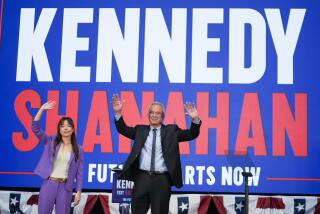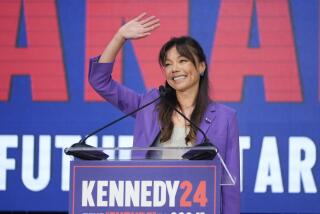What’s relevant? What matters? What’s real? All questions tackled by ‘The Front Runner’

Two writers at the same keyboard can be tricky; three can be downright treacherous. And yet there we were, a trio of writers brought together by our passion to tell the same true story, each having traveled an unusual path to get here.
Our three-piece band (kind of like the Police or maybe Nirvana) consisted of a longtime political journalist, a former senior operative for presidential candidates and the son of the guy who made “Ghostbusters.”
The first thing we did was to sit down and watch “The Candidate,” Michael Ritchie’s classic — and overlooked — film from 1972. It felt chaotic, in a good way. It felt spontaneous. More than anything, it felt real. Like you were actually watching a young and naive Robert Redford run for Senate, while the hoary aides around him bickered over sandwich orders.
That’s what we were after in 2018. “Chasing real” is how we thought of it. Real is messy and complicated. “Real” drops you into an unfamiliar world and challenges you to keep up. “Real” has no heroes or villains, no easy answers or perfectly crafted soliloquies delivered to the swell of stirring horns.
Fortunately, real — in the context of a political campaign — is something we knew really well. We’d been in the back rooms of a presidential headquarters, or in the back of the campaign bus with the other reporters, or at the hotel bars where half the business of any campaign used to be transacted. We knew a lot of the actual characters in the film.
[“Front Runner”] is a film that’s wrestling with what’s important in our public life and who gets to decide.
The challenge was in translating all that to the page — to somehow capture all the shorthand and disorder of politics in a way that made sense. Most scripts employ “dual dialogue” — that is, actors talking over each other — as an occasional device. For us, it was practically a default.
If the dialogue was focusing on a conversation over here, we asked ourselves: Wait, what’s happening over there?
The idea was to make a film that asked you to follow not just your eyes but your ears too. A film that was always asking you: What’s relevant here? What matters? What do I need to know?
Because that’s what “The Front Runner” is ultimately about. It’s a film that’s wrestling with what’s important in our public life and who gets to decide.
So the first time you meet Democratic presidential candidate Gary Hart’s assembled campaign team, they’re running down the schedule, and trading information on the nearest liquor store, and dancing around the candidate’s marriage – all at the same time. And when the reporters and editors at the Washington Post are making a crucial reporting decision, they’re also deciding whether to take a stick of chewing gum or not. That’s how those meetings actually go.
FULL COVERAGE: The Envelope awards coverage and interviews »
By the time it was through, we couldn’t have told you who wrote which line, or whose idea it was to have the pizza delivery guy come barging into the middle of a scene. (Otherwise, we’d have broken our “no soliloquies” rule.) We threw thousands of words onto a white board, passed pages back and forth, ate too much take-out and laughed like hell.
Another unusual thing: Our collaboration didn’t stop when the script was finished. All of us — and not just the one of us who directed the whole thing — were on set for the shoot. We churned out new bits of dialogue and schooled the on-screen phone-bankers in how to raise cash. (We also dropped in a radio stand-up by a reporter named “Mike Ritchie” — a small homage.)
And then the coolest thing: The more the scores of actors who played aides and reporters got into the rhythm of talking over each other in every scene, the more they began to bond and banter after hours, and the more our set began to feel like the actual campaign we’d set out to re-create.
Our little band of three grew into a symphony of hundreds, and from that cacophony of chords came the sound of something real.
More to Read
From the Oscars to the Emmys.
Get the Envelope newsletter for exclusive awards season coverage, behind-the-scenes stories from the Envelope podcast and columnist Glenn Whipp’s must-read analysis.
You may occasionally receive promotional content from the Los Angeles Times.






